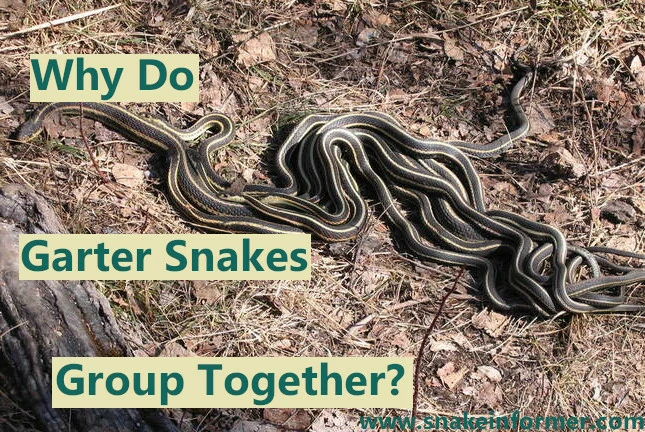Garter snakes are medium-sized snakes easily recognizable by the distinctive stripes running lengthwise along their scales. They are one of the most common snakes in North America and can often be found in large groups, particularly at certain times of the year.
Garter Snakes gather in groups for several reasons, including to retain body heat and moisture, to gain greater protection from predators, to share and receive useful information (such as good hiding spots), or even to mate.
Garter snakes are not the only snakes that show social behavior.
Many other snakes, such as Cottonmouth Snakes, and Western diamondback rattlesnakes, are also known to show various forms of social behavior (more information on that is below).
Garter Snakes are Social Animals
Most snakes are solitary creatures and do not form social groups.
However, this is not the case for garter snakes.
Researchers studying Butler’s garter snakes (Thamnophis butleri), found that they prefer to hang out together, and also have groups of ‘friends’ who they prefer to associate with.
These groups are usually made up of three to four snakes, but larger groups may have up to 46 individuals.
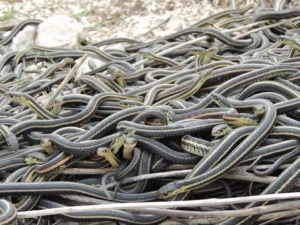
Older females, tend to have the most friends and act as the leaders that tie the groups together and guide their movement.
Generally, garter snakes mostly associate with other snakes of the same sex and similar age. However, younger females seem to follow older females around.
5 Reasons Why Garter Snakes Group Together
Social behavior can be beneficial, especially for younger garter snakes.
Here are 6 reasons why these snakes like to form groups.
1. To Retain Moisture, and Body Heat
Like all reptiles, garter snakes are ectothermic (cold-blooded) animals, meaning they can not regulate their internal body temperature.
When the environmental temperatures rise or fall, so does their internal temperature.
During cold weather, garter snakes may retreat to protected spaces (such as rock crevices, or animal burrows), and form groups to protect themselves from the cold.
By clustering together, they reduce individual heat loss and maintain a more stable body temperature.
2. To Hibernate
In cold climates, garter snakes survive the winter by brumating (think of it as a kind of hibernation, for cold-blooded animals).
They seek out protected places where they will not freeze, such as under rock piles, in tree stumps, or in animal burrows that are deep enough that the frost does not penetrate all the way to the bottom.
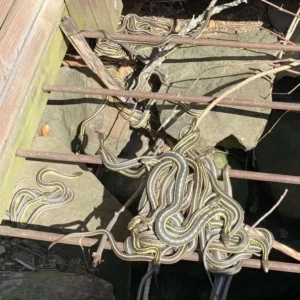
Typically, multiple garter snakes congregate in a single den and hibernate together.
By lying together and forming tight coils, garter snakes can prevent heat loss and keep their body temperature above freezing, all winter long.
3. To Get Better Protection From Predators
Garter snakes are preyed on by hawks, owls, crows, eagles, raccoons, foxes weasels, large predatory fish, and even larger snakes such as Kingsnakes.
By most estimates, only about 5 – 20% of wild garter snakes live to sexual maturity.
For this reason, these snakes developed several ways to defend themselves, including, camouflage, musking, and quick reflexes to escape from predators.
Grouping together can also offer protection from predators.
A single snake stands out and can be easily caught by predators. However, the sheer number of moving bodies in a large gathering of snakes may overwhelm or confuse many would-be predators.
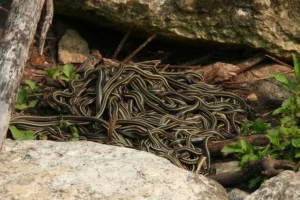
In other words, being part of a large group reduces the probability that any one individual snake will be targeted.
4. To Share, and Receive Useful Information
Gathering in groups enables garter snakes to share, or receive useful information.
For example, if one garter snake has discovered a good spot to hunt for prey, or to shelter – it can lead others in the group to that location.
In this way, information is shared.
5. To Mate
In the spring, male garter snakes emerge out of hibernation (brumation) first and prepare for mating.
About two weeks later, the female emerges and emits pheromones to attract males.
Males, attracted by pheromones then rush females to mate.
If several males swarm a single female, a “mating ball” is formed – with males competing to push other males aside and get into the right position to mate.
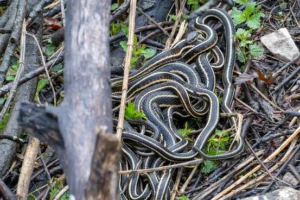
Once the female has mated, she stops emitting her pheromones and the males leave her alone, within a few minutes.
A single female may hatch a brood, which can be traced to multiple male garter snakes.
Garter Snakes Are Not the Only Social Snakes
Garter snakes are not the only snakes snakes that show social behavior.
Many other snake species have been observed forming large groups for various reasons.
1. Rattlesnakes
Researchers studying western diamondback rattlesnakes (Crotalus atrox) found that they formed social groups, made up of individuals that they frequently interacted with.
They rarely, if ever, interacted with snakes outside of their social groups, even if they have overlapping home ranges.
Rattlesnakes of the same social group return to the same communal dens, year after year, to spend the cold winters together.
While in the dens, they encounter and engage with one another.
2. Cottonmouth Snakes
Researchers from the University of Florida studying Cottonmouth snakes (Agkistrodon piscivorus), also known as water moccasins, noticed male and female snakes forming pairs.
These pairs foraged and stayed together for long periods.
Conclusion
Garter snakes form groups primarily to regulate their body temperature, avoid predators, or mate.
This behavior is especially beneficial to younger snakes that are still growing, and learning about their environments.
Many other snake species show hints of social behavior, for various reasons.
New research is starting to tell us that many snakes are not solitary creatures they were long thought to be.
Featured image credit: Douglas Tate (CC BY-NC 4.0)
Sources:
Morgan Skinner, Noam Miller (2020). Aggregation and social interaction in garter snakes (Thamnophis sirtalis sirtalis). https://link.springer.com/article/10.1007/s00265-020-2827-0
Janet E Joy, David Crews, Hibernation in garter snakes (Thamnophis Sirtalis Parietalis): seasonal cycles of cold tolerance, Comparative Biochemistry, and Physiology Part A: Physiology, Volume 87, Issue 4. https://doi.org/10.1016/0300-9629(87)90045-4.
Wharton, C. H. (1966). Reproduction and Growth in the Cottonmouths, Agkistrodon piscivorus Lacépède, of Cedar Keys, Florida. Copeia, 1966(2), 149–161. https://doi.org/10.2307/1441121
Hi, my name is Ezra Mushala, i have been interested animals all my life. I am the main author and editor here at snakeinformer.com.

